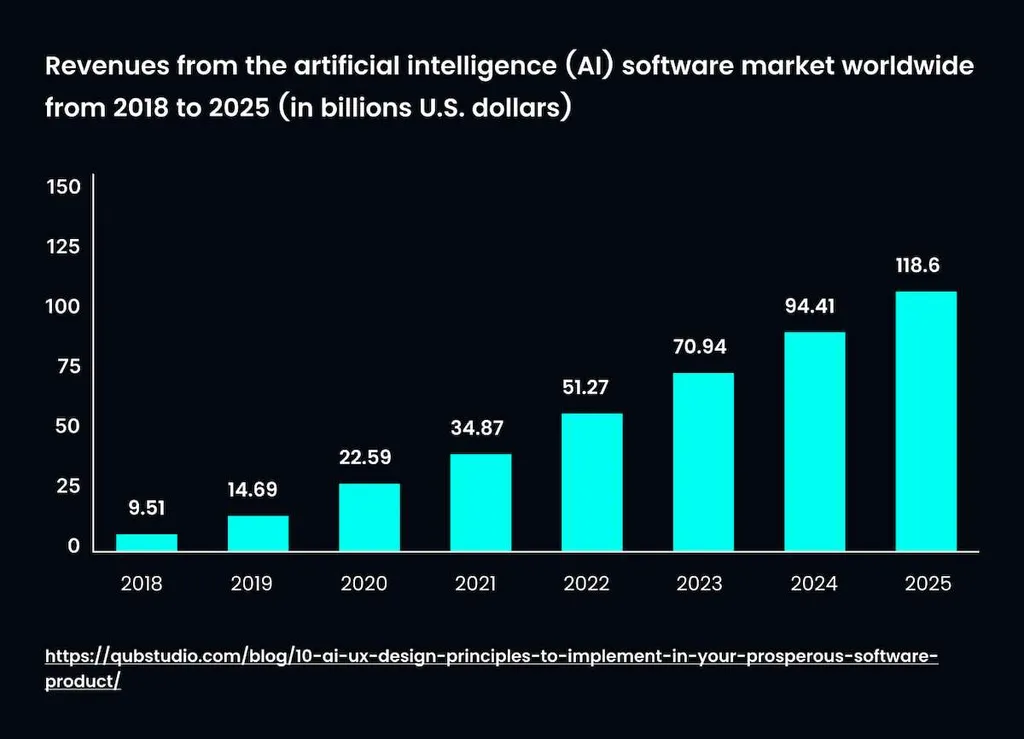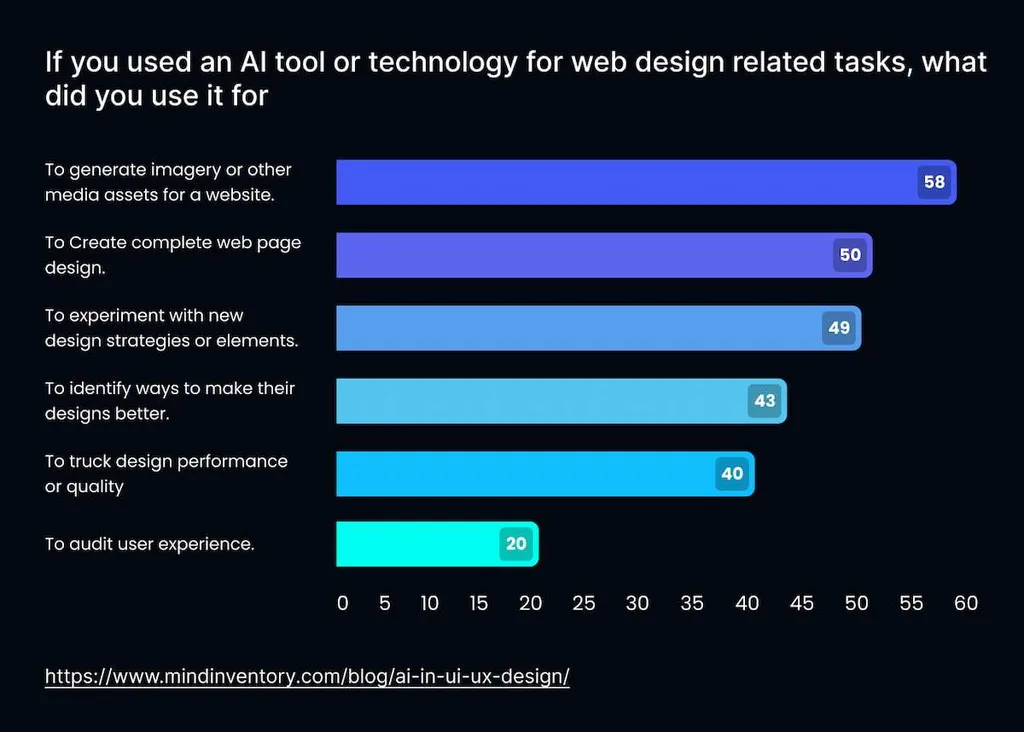The aesthetic design of the website or app is essential. Still, a great user experience (UX) depends on a deep understanding of the basic requirements of consumers. This knowledge is the foundation of successful businesses and, conversely, the demise of failing ones. The field of UX design is seeing a notable transformation due to the introduction of a new artificial intelligence technology called large language models (LLMs). Modern businesses are quickly embracing the transition to change the conventional ideas of AI UX design. Today, we’ll touch on how the LLM UX is changing user experience and offer you the tips you need to thrive.
What are Large Language Models (LLMs) in UX?
The AI software market revenue is expected to reach almost $150 billion by 2025. With the increasing demand for revolutionary AI products, UI/UX designers are exploring new tech: LLMs. They are advanced GenAI models integrated into UX to amp up interactions, offer tailored responses, and spruce up user experience.

LLMs leverage massive datasets of textual information. They’re meticulously trained to achieve proficiency in both human language comprehension and generation. Consequently, LLMs are instrumental in crafting more intuitive and responsive graphical user interface (GUI). Here are some examples of their contributions:
- Development of chatbots. They use virtual assistants which can answer users’ questions in a natural and engaging way.
- Create personalized content. LLM UX personalizes website copy and instructions based on user behavior and preferences.
- Improving accessibility. They help create alternative text descriptions for images.
MetaDialog AI LLMs change the way your customers interact with your digital products. These models are the latest words in technology that understand and create human-like output. Are you looking for intuitive and responsive user interfaces? Then such technology will be indispensable for you. UX designers get an opportunity to create brand-new experiences — both visually appealing and responsive to user needs.
Why are LLMs Important for UX?
LLMs come in handy for designers in many ways. They affect the work of specialists and benefit the entire company. Let’s take a look at some important reasons why UX designers should consider an LLM:
- Customer focus is the basis of MetaDialog AI in product design. With a deep understanding of user needs, context and behavior, our model enables experts to gain new insights. In turn, specialists are now able to create artificial intelligence interactions that look natural and supportive.
- With LLM UX, you create products that are accessible to everyone. AI-powered interfaces serve a diverse user base, including people with disabilities.
- UX designers design a more personalized user experience. LLMs are allowed to design such an experience that will meet the interests and requirements of individual users. When we simplify tasks like helping users or answering their questions, we can amp up the AI user experience by making them faster and more efficient.
- LLMs analyze vast amounts of data to gain insights that help UX designers make informed decisions. It is a direct way to maximize user interaction.
In summary, UX designers can create intelligent, user-centered experiences that completely transform a brand’s digital face.
Real Examples of LLMs in UX
According to a survey, web designers are adopting AI at an alarming rate: 93% of them used LLM tools for design work last year. In UX design, this trend highlights the increasing synergy between human knowledge and AI capabilities. Let’s examine five cases of how MetaDialog AI-powered LLMs can augment the skillsets of UX professionals.

Rapid prototyping & iteration
During the prototype phase, LLMs offer data-based insights and design suggestions that stimulate investigation. With the assistance of these technologies, UX experts continue to be the primary creative force behind this effort. Integration allows for the exploration of various design approaches and the use of the rich data that LLMs supply. The result? More efficient iteration cycles.
Personalized experiences at scale
LLMs provide UX experts with many insights into user behavior, preferences, and needs. By analyzing the data, designers are able to create highly customized experiences that profoundly impact individual users. This preserves the vital human element that UX experts provide while fostering deeper interactions and engagement.
Unveiling usability blind spots
LLM UX supports usability testing by UX experts as they mimic user behaviors and offer precise, in-depth feedback. These programs detect possible problems, development opportunities, and trends in user activity. Ultimately, the designers can enhance their works based on real-time data, leading to earlier and more efficient and user-friendly layouts.
Intelligent content generation
LLMs are proving to be invaluable collaborators for UX specialists. They provide insightful suggestions and data-driven recommendations to craft content that is highly relevant and adapts to the user’s context. However, the ultimate control over the content’s direction rests with UX professionals. They ensure the messaging aligns seamlessly with user needs while preserving a genuine human touch.
Accessibility for all
Designers can now create layouts that are more inclusive. LLMs spot possible accessibility obstacles and suggest solutions. It proves that digital products cater to a wider audience, sticking to established accessibility standards and best practices.
How Can You Benefit from LLMs?
It is not enough to just integrate LLMs into online apps. Startups have to be very careful about the context in which they employ these technologies. The key is to make sure that they correspond with certain stages of the user journey. Such an approach optimizes possibilities to offer pertinent help while reducing the possibility of overburdening users with decision-making.
Having clearly defined decision points and user flows is the cornerstone. Businesses may automate time-consuming UI activities if they strategically use AI, freeing up designers to concentrate on their primary competency — creating user-centric experiences.
To put it simply, the smooth integration of LLM UX is critical to the future of online applications. LLMs are now essential guides to users as they explore the digital world. Startups must emphasize striking a harmonic balance between technology innovation and a thorough grasp of human needs.
So, the best advice is to prioritize the creation of intuitive user flows and decision points. The method reduces decision fatigue and opens access to individualized assistance and custom solutions.
Final Words
The mix of LLM UX development ushers in a new innovation path. When we tap into the potential of these AI technologies, we can forge products that go beyond mere functionality and visual appeal.
LLMs offer a set of tools that enhance the user journey across all digital interaction points. With it, you can facilitate rapid prototyping and the generation of personalized content. However, successful LLM integration depends on a user-centric approach. Business owners should prioritize intuitive user flows and context-sensitive interactions. It is the only way to ensure that LLMs enhance, not overwhelm, the user experience.
LLM UX is an example of how AI helps experts. The technology enables designers to create intelligent designs adapted to users’ needs. Ultimately, MetaDialog AI redefines what is possible in the digital industry. If you’re ready to revamp your interactions with clients, choose MetaDialog LLMs.
